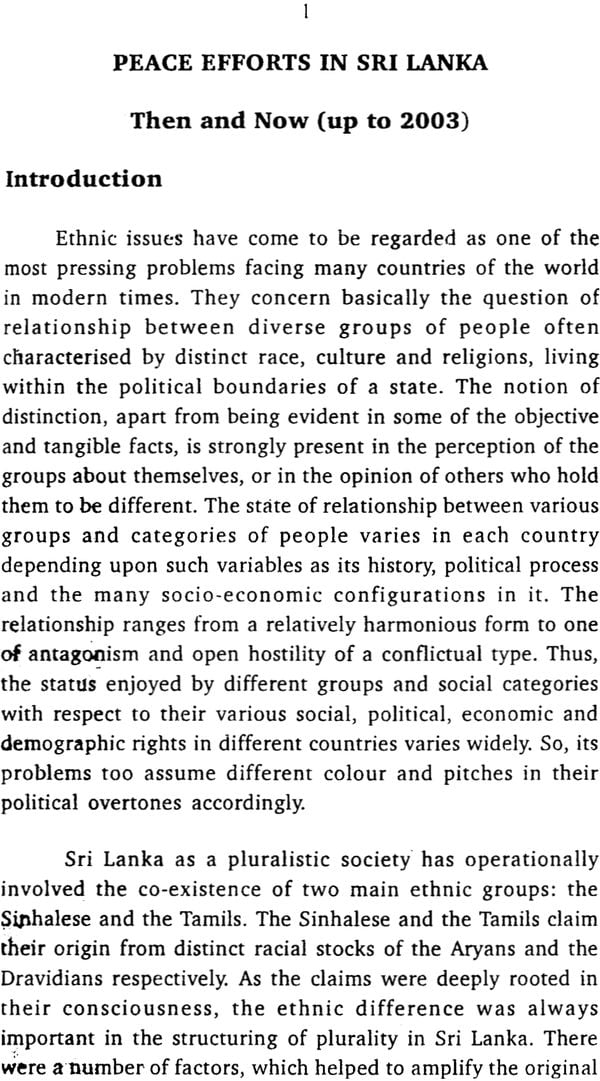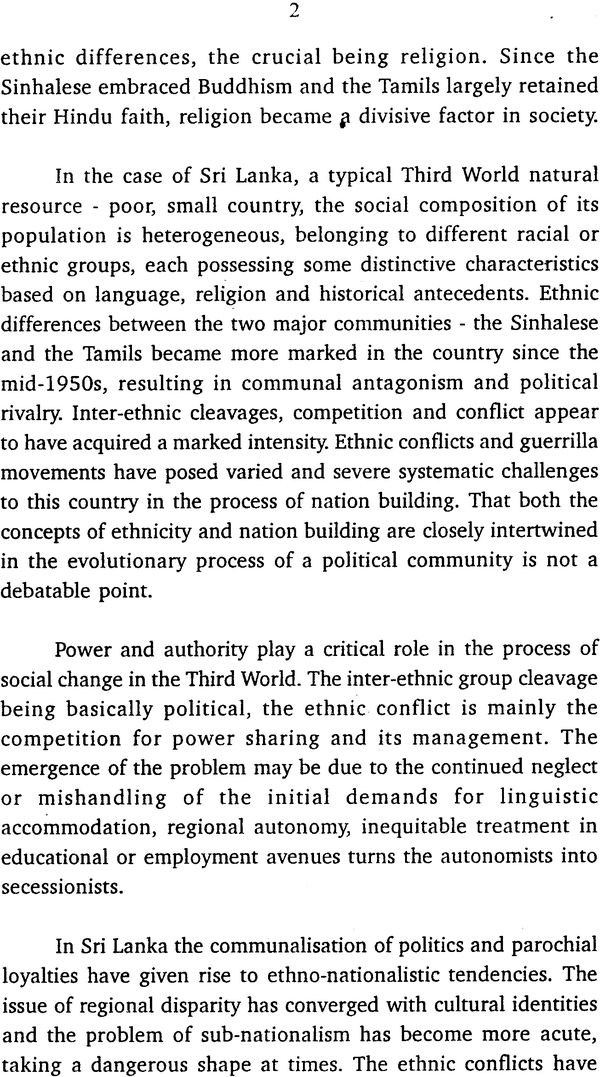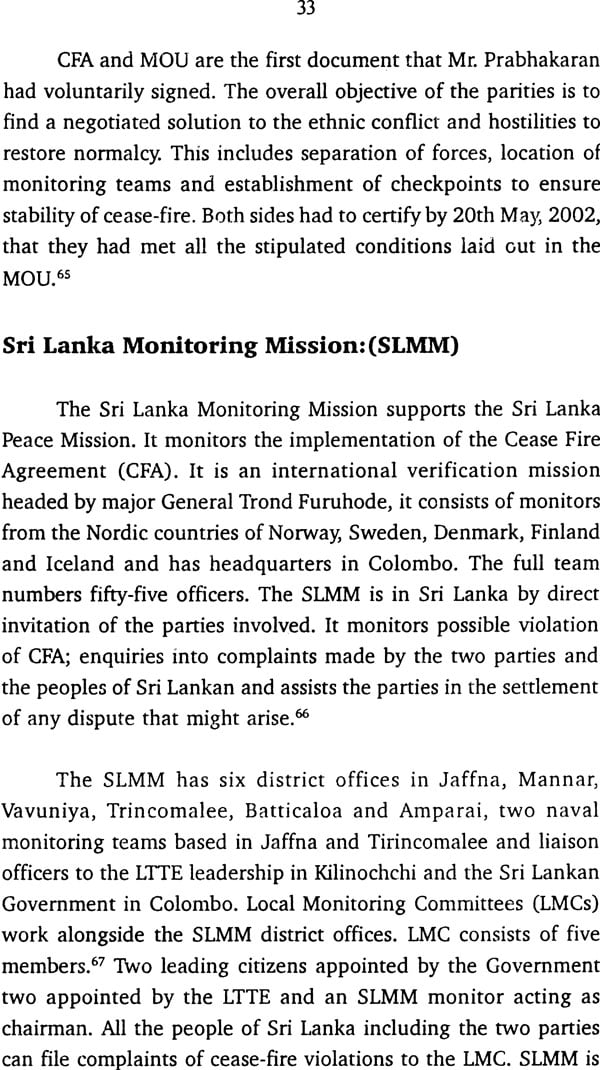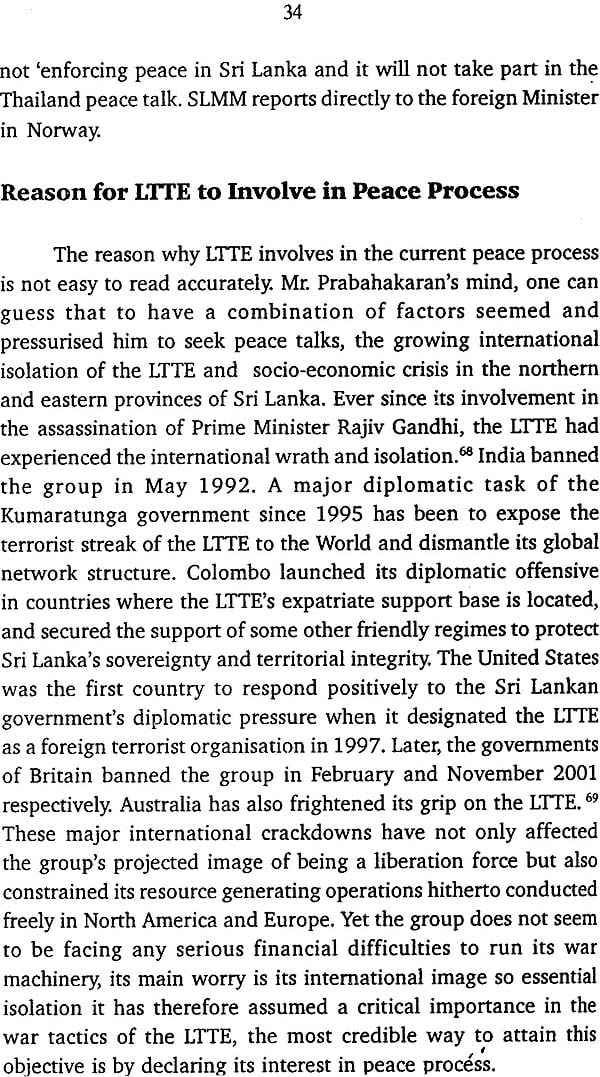
Peace Efforts in Sri Lanka (Then and Now Upto 2003)
Book Specification
| Item Code: | NAJ412 |
| Author: | Dr. S. Manivasakan |
| Publisher: | University of Madras |
| Language: | English |
| Edition: | 2007 |
| ISBN: | 9788190920728 |
| Pages: | 59 |
| Cover: | Paperback |
| Other Details | 9.5 inch X 6.0 inch |
| Weight | 110 gm |
Book Description
Dr. S. Manivasakan had obtained his M.A., in the Department of Defence Studies M. Phil., from Department of Geography and Ph.D. in the Defence and Straight Studies, University of Madras. Since 2000, he has been working as a Teaching Faculty in the Centre for south and Southeast Asian Studies, University of madras. Prior to his appointment I the Centre, he worked as a Guest Faculty in the Department of Defence and Stratigic Studies, University of Madras.
He has organized several Seminars / Conferences at National and International level including the International Conference on ‘Terrorism’ (2002). The papers presented in the conference ignited interest and based on the discussion, proceedings of the conference ignited interest and based on the discussion, proceedings of the conference was brought out as a Edition Book on ‘Terrorism’ (2003). Dr. S. Manivaskan has been researching on Sri Lankan ethnic problems and impact on India. He has published two books on the ‘Strategic Dimensions of Sri Lanka Ethnic Conflict’ (2000) and Guerrilla War: Theory and Practices in Sri Lanka’ (2007).
He has published many research papers in several National and International Professional Journals. He has visited several universities in Southeast Asia and gained rich experience in South and Southeast Asian Studies.
Ethnic issues have come to be regarded as one of the most pressing problems facing many countries of the world in modern times. They concern basically the question of relationship between diverse groups of people often characterised by distinct race, culture and religions, living within the political boundaries of a state. The notion of distinction, apart from being evident in some of the objective and tangible facts, is strongly present in the perception of the groups about themselves, or in the opinion of others who hold them to be different. The state of relationship between various groups and categories of people varies in each country depending upon such variables as its history, political process and the many socio-economic configurations in it. The relationship ranges from a relatively harmonious form to one of antagonism and open hostility of a conflictual type. Thus, the status enjoyed by different groups and social categories with respect to their various social, political, economic and demographic rights in different countries varies widely. So, its problems too assume different colour and pitches in their political overtones accordingly.
Sri Lanka as a pluralistic society" has operationally involved the co-existence of two main ethnic groups: the Sinhalese and the Tamils. The Sinhalese and the Tamils claim their origin from distinct racial stocks of the Aryans and the Dravidians respectively. As the claims were deeply rooted in their consciousness, the ethnic difference was always important in the structuring of plurality in Sri Lanka. There were a number- of factors, which helped to amplify the original ethnic differences, the crucial being religion. Since the Sinhalese embraced Buddhism and the Tamils largely retained their Hindu faith, religion became a divisive factor in society.
In the case of Sri Lanka, a typical Third World natural resource - poor, small country, the social composition of its population is heterogeneous, belonging to different racial or ethnic groups, each possessing some distinctive characteristics based on language, religion and historical antecedents. Ethnic differences between the two major communities - the Sinhalese and the Tamils became more marked in the country since the mid-19S0s, resulting in communal antagonism and political rivalry. Inter-ethnic cleavages, competition and conflict appear to have acquired a marked intensity. Ethnic conflicts and guerrilla movements have posed varied and severe systematic challenges to this country in the process of nation building. That both the concepts of ethnicity and nation building are closely intertwined in the evolutionary process of a political community is not a debatable point.
Power and authority play a critical role in the process of social change in the Third World. The inter-ethnic group cleavage being basically political, the ethnic conflict is mainly the competition for power sharing and its management. The emergence of the problem may be due to the continued neglect or mishandling of the initial demands for linguistic accommodation, regional autonomy, inequitable treatment in educational or employment avenues turns the autonomists into secessionists.
In Sri Lanka the communalisation of politics and parochial loyalties have given rise to ethno-nationalistic tendencies. The issue of regional disparity has converged with cultural identities and the problem of sub-nationalism has become more acute, taking a dangerous shape at times. The ethnic conflicts have sharpened to the extent the Tamils aspire to exercise the right of national self-determination. Such tendency has not only weakened the process, but also resulted the emergence of the state as a primary factor in national unity. Therefore, in Sri Lanka, nationalism has been induced or 'Created' product instead of being a natural, evolutionary process.
Ethnic Crisis and its Implications in India
After the July 1983 riots, there was a massive support for Tamil militancy. The Tamil guerrillas in their separatist movement began to attack Sri Lankan security forces and others had opposed them. Hence, President Jayewardene perceived that his government was facing threats from within and outside the country, and that the chauvinistic sections of the Sinhala community, acting in collusion with the disgruntled elements in Sri Lankan ill-disciplined Army might overthrow his regime, also considering the Tamil sentiment in India (Tamilnadu), as a result of high toll of Tamil lives and property and gee-strategic importance of Sri Lanka to India's security. Sinhalese dominated government feared that India might intervene militarily as it did during East Pakistan crisis in 1971 and would work for Tamil cause. Till Indo-Sri Lanka peace agreement was signed, the fear of Indian domination has largely guided the diplomatic and politico-security decision-making in Sri Lanka. Thus, the UNP government sought military assistance from many extra-regional and anti-India regional powers to meet the crisis.
The ethnic conflict between Sinhalese and Tamils during the last two decades not only affected the stability of the Island nation, but also had serious implications on India in regard to her socio-political, economic and military interests. The antagonism between the Sinhalese and Tamils led to several communal riots since 1956, when Sinhala was made the only official language. But, the riot in July 1983 and subsequent ethnic conflicts in Sri Lanka had greatly affected India's internal political stability. Implications for the Indian political stability could be seen at that time when the people of Tamil Nadu organising bandhs and other political agitations urged the government of India to intervene militarily in Sri Lanka to save the Tamil cause there. This was one of the reasons for India to recognise the Tamil problem in Sri Lanka.
Since the outbreak of July 1983 riots in Sri Lanka, Indo-Sri Lankan relations were marked by mutual distrust and suspicion. This was evident, when the Sri Lankan government suffering from small power complex and fear of Indian invasion or India phobia sought military assistance from many pro-western countries including the USA to save the government. Moreover, the Sri Lankan government repeatedly warned the people of Sri Lanka that India might militarily intervene for the Tamil cause,' as it did during East Pakistan crisis in 1971. On the other hand, India remained suspicious about the Sri Lankan government's motives as India regarded Sri Lanka as lying within its defence perimeter. Therefore, India made every effort to maintain the existing balance of power in the South Asian region.
Peace Efforts by India
India had been observing the emerging situation in Sri Lanka with great concern. India is the most seriously and directly affected neighbouring country due to the Sri Lankan ethnic crisis. The refugee problem was not only an economic burden but also social, economic and political tensions within Tamil Nadu and other part of India. As a result, India made some efforts to settle the Sri Lankan ethnic crisis.









